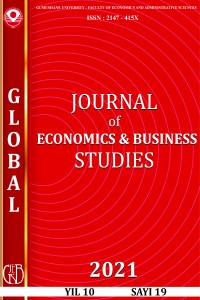Öz
The aim of this study is to adapt the “Emotional Manipulation” which is the subscale of the “Emotional Manipulation” scale developed by Austin et al. (2007) used by Grieve and Mahar (2010), Grieve (2011), Grieve and Panebianco (2013), Hyde and Grieve (2014) and Nagler et al. (2014) into Turkish and examine validity and reliability of the scale. The sample of the study consists of 141 employees from different occupational groups (officeholder, teacher, academician, private sector employee) determined by convenience sampling method. Frequency analysis, reliability analysis, explanatory factor analysis and confirmatory factor analysis were used for data analysis. The Cronbach’s Alpha value of the scale was calculated as α = 0.926. According to the explanatory factor analysis (EFA), the scale was one-dimensional. According to the results of the confirmatory factor analysis (CFA) to test the construct validity of the scale, the obtained values confirm the one-dimensional structure and goodness of fit values were found to be good and acceptable. As a result, the Turkish version of the emotional manipulation scale was found to be valid and reliable according to the data collected from the relevant sample group.
Kaynakça
- AUSTIN, Elizabeth J., Daniel FARRELLY, Carolyn BLACK ve Helen MOOR (2007), “Emotional Intelligence, Machiavellianism and Emotional Manipulation: Does EI Have a Dark Side?”, Personality and Individual Differences, 43(1): 179-189.
- BRISLIN, Richard W., Walter J. LONNER ve Robert M. THORNDİKE (1973), Cross-Cultural Research Methods, New York: John Wiley - SonsPub.
- BÜYÜKÖZTÜRK, Şener (2010), Sosyal Bilimler için Veri Analizi El Kitabı, Ankara: Pegem Akademi Yayınları.
- GOLEMAN, Daniel, Richard BOYATZIS ve Annie MCKEE (2006), Yeni Liderler, 5. Baskı, İstanbul: Varlık Yayınları.
- GRIEVE, Rachel (2011), “Mirror Mirror: The Role of Self-Monitoring and Sincerity in Emotional Manipulation”, Personality and Individual Differences, 51, 981-985.
- GRIEVE, Rachel ve Doug MAHAR (2010), “The Emotional Manipulation–Psychopathy Nexus: Relationships with Emotional Intelligence, Alexithymia and Ethical Position”, Personality and Individual Differences, 48, 945-950.
- HAJI, Ishtiyaque ve Stefaan E. CUYPERS (2006), “Moral Responsibility and The Problem of Manipulation Reconsidered”, International Journal of Philosophical Studies, 12:4, 439-464, https://doi.org/10.1080/0967255042000278076
- HINKIN, Timothy R. (1998), “A Brief Tutorial on Development of Measures for Use in Survey Questionnaires”, Organizational Research Methods, 1(1), 104-121.
- HYDE, Jane ve Rachel GRIEVE (2018), “The Dark Side of Emotion at Work: Emotional Manipulation in Everyday and Work Place Contexts”, Personality and Individual Differences, 129, 108-113.
- NAGLER, Ursa. K. J., Katharina. J REITER, Marco R. FURTNER ve John F. RAUTHMANN (2014), “Is There a “Dark Intelligence”? Emotional Intelligence is Used By Dark Personalities to Emotionally Manipulate Others”, Personality and Individual Differences, 65, 47–52. https://doi.org/10.1016/j.paid.2014.01.025.
- SALOVEY, Peter ve John D. MAYER (1990), “Emotional Intelligence”, Imagination, Cognition, and Personality, 9, 185–211.
- SCHERMELLEH-ENGEL, Karin, Helfried MOOSBRUGGER ve Hans MÜLLER (2003), “Evaluating the Fit of Structural Equation Models: Tests of Significance and Descriptive Goodness-of-Fit Measures”, Methods of Psychological Research Online, 8(2), 23-74.
Öz
Bu çalışmanın amacı, Austin ve diğerleri (2007) tarafından geliştirilen “Duygusal Manipülasyon” ölçeğinin Grieve ve Mahar (2010), Grieve (2011), Grieve ve Panebianco (2013), Hyde ve Grieve (2014) ve Nagler vd. (2014) tarafından kullanılan alt ölçeği olan “Duygusal Manipülasyon” un Türkçe uyarlamasını yapmak, geçerlilik ve güvenilirliğini incelemektir. Araştırma kolayda örnekleme yöntemiyle belirlenen, farklı meslek gruplarından (devlet memuru, öğretmen, akademisyen, özel sektör çalışanı) 141 çalışan ile gerçekleştirilmiştir. Verilerin analizinde frekans analizi, güvenilirlik analizi, açıklayıcı faktör analizi, doğrulayıcı faktör analizlerinden yararlanılmıştır. Ölçeğin Cronbach Alfa değeri α=0,926 olarak hesaplanmıştır. Açıklayıcı faktör analizi (AFA) sonuçlarına göre ölçek tek boyutludur. Ölçeğin yapı geçerliliğini test etmek için yapılan doğrulayıcı faktör analizi (DFA) sonuçlarına göre, elde edilen değerler tek boyutlu yapıyı doğrulamaktadır ve uyum iyiliği değerlerinin iyi ve kabul edilebilir düzeyde olduğu belirlenmiştir. Sonuç olarak duygusal manipülasyon ölçeğinin Türkçe formunun ilgili örneklem grubundan toplanan verilere göre geçerli ve güvenilir olduğu bulunmuştur.
Anahtar Kelimeler
Kaynakça
- AUSTIN, Elizabeth J., Daniel FARRELLY, Carolyn BLACK ve Helen MOOR (2007), “Emotional Intelligence, Machiavellianism and Emotional Manipulation: Does EI Have a Dark Side?”, Personality and Individual Differences, 43(1): 179-189.
- BRISLIN, Richard W., Walter J. LONNER ve Robert M. THORNDİKE (1973), Cross-Cultural Research Methods, New York: John Wiley - SonsPub.
- BÜYÜKÖZTÜRK, Şener (2010), Sosyal Bilimler için Veri Analizi El Kitabı, Ankara: Pegem Akademi Yayınları.
- GOLEMAN, Daniel, Richard BOYATZIS ve Annie MCKEE (2006), Yeni Liderler, 5. Baskı, İstanbul: Varlık Yayınları.
- GRIEVE, Rachel (2011), “Mirror Mirror: The Role of Self-Monitoring and Sincerity in Emotional Manipulation”, Personality and Individual Differences, 51, 981-985.
- GRIEVE, Rachel ve Doug MAHAR (2010), “The Emotional Manipulation–Psychopathy Nexus: Relationships with Emotional Intelligence, Alexithymia and Ethical Position”, Personality and Individual Differences, 48, 945-950.
- HAJI, Ishtiyaque ve Stefaan E. CUYPERS (2006), “Moral Responsibility and The Problem of Manipulation Reconsidered”, International Journal of Philosophical Studies, 12:4, 439-464, https://doi.org/10.1080/0967255042000278076
- HINKIN, Timothy R. (1998), “A Brief Tutorial on Development of Measures for Use in Survey Questionnaires”, Organizational Research Methods, 1(1), 104-121.
- HYDE, Jane ve Rachel GRIEVE (2018), “The Dark Side of Emotion at Work: Emotional Manipulation in Everyday and Work Place Contexts”, Personality and Individual Differences, 129, 108-113.
- NAGLER, Ursa. K. J., Katharina. J REITER, Marco R. FURTNER ve John F. RAUTHMANN (2014), “Is There a “Dark Intelligence”? Emotional Intelligence is Used By Dark Personalities to Emotionally Manipulate Others”, Personality and Individual Differences, 65, 47–52. https://doi.org/10.1016/j.paid.2014.01.025.
- SALOVEY, Peter ve John D. MAYER (1990), “Emotional Intelligence”, Imagination, Cognition, and Personality, 9, 185–211.
- SCHERMELLEH-ENGEL, Karin, Helfried MOOSBRUGGER ve Hans MÜLLER (2003), “Evaluating the Fit of Structural Equation Models: Tests of Significance and Descriptive Goodness-of-Fit Measures”, Methods of Psychological Research Online, 8(2), 23-74.
Ayrıntılar
| Birincil Dil | Türkçe |
|---|---|
| Bölüm | Makaleler |
| Yazarlar | |
| Yayımlanma Tarihi | 11 Ağustos 2021 |
| Yayımlandığı Sayı | Yıl 2021 Cilt: 10 Sayı: 19 |

Bu eser Creative Commons Atıf-GayriTicari 4.0 Uluslararası Lisansı ile lisanslanmıştır.

